Recently, I learned about a new portable by Kaito Electronics: the Kaito KA108. While there are a number of compact portables on the market, the KA108 really caught my attention because it features a built-in digital recorder. Which is to say, you can listen to a station on shortwave, press a button, and the KA108 will record it to a MicroSD card. Pretty cool, right? It’s also the first shortwave portable I’ve ever known that offers a scheduling feature for recordings.
In the past there have been a few shortwave portables with digital recording capabilities, but most of these have been plagued with poor performance. So this time, I had my fingers crossed that Kaito might have produced a winner.
Having used the KA108 for several days now, my initial review follows, with a focus on shortwave as well as mediumwave performance.
User’s Manual
The KA108 actually ships with two manuals: a quick start reference guide and a proper highly-detailed user’s manual.
The manual is written in English and is quite descriptive, despite a number of spelling and grammar errors that should have been caught before going to print. It’s obvious that Kaito didn’t hire a native English speaker/professional editor to check their copy. (I don’t understand why a company would go to the expense to produce a manual without having it professionally edited…Kaito, please take note!) Fortunately, these spelling and grammar errors, while annoying, can be overlooked and/or deciphered by most English-speaking readers.
Tuning
On the plus side, the KA108 sports a full number keypad for direct frequency entry. This makes tuning to a known frequency a very simple process––with one exception (see below). There’s also a tuning wheel on the right side of the radio.
Using the keypad requires some getting used to, however. Most of us––myself included––are familiar with traditional numeric keypads, but the KA108 inexplicably changes the game plan: as you can see above, the “0” button is located on the lower right side of the main keypad. So it took me a few hours of use before I could reliably key in a frequency without looking at the radio.
In my humble opinion, Kaito should have moved the number pad up one row, positioned the “ATS” button to the lowest row on the left, the “0” button to its immediate right, and completed the bottom row with the “Rewind/Play/Fast-Forward” buttons.
Another annoyance––and this is a big one for me–-is that the KA108 has extended muting between frequency changes. It makes band-scanning a frustrating experience. I made a short video demonstrating this:
Audio
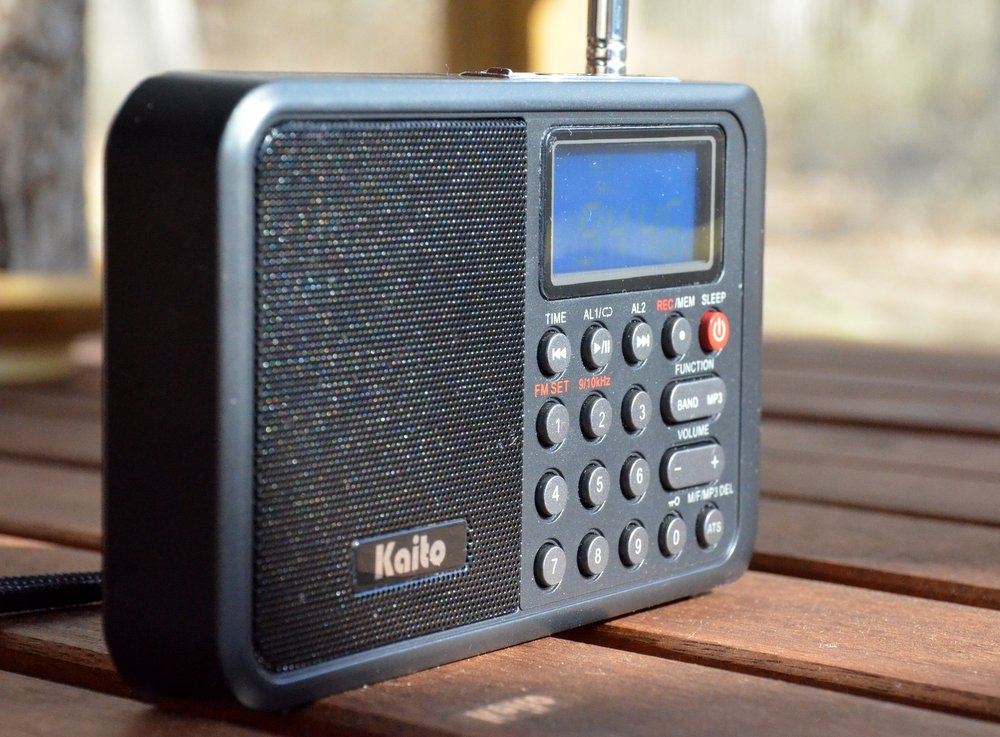 The KA108 is designed around a very innovative small speaker with an acoustic chamber that significantly boosts bass response. This is the same speaker used in the Melson S8 that I reviewed some time ago.
The KA108 is designed around a very innovative small speaker with an acoustic chamber that significantly boosts bass response. This is the same speaker used in the Melson S8 that I reviewed some time ago.
The audio fidelity is excellent on FM, and when playing back a full-fidelity digital recording. Unfortunately, when tuned to the AM broadcast (mediumwave) band or to the shortwave bands, the KA108 falls short; the bass response actually becomes an impediment to listening.
In a nutshell: the KA108 audio has issues. A further explanation of the KA108’s audio is described in the performance notes that follow.
FM Performance
On a positive note, the Kaito KA108 has respectable FM reception. I was able to receive all my benchmark FM stations with little trouble, and the KA108 maintained a strong lock on all signals.
And as mentioned above, KA108 audio via the built-in speaker is much better on FM than on any other band. Indeed, on FM, the KA108 produces rich, full-fidelity audio that can easily fill a room. Audio is similar to that of the Melson M7 and the Melson S8.
If you’re seeking a nice FM portable with robust audio, you’ll enjoy the KA108.
Shortwave Performance
I’m quite disappointed with the KA108’s shortwave performance.
Almost immediately after unboxing the KA108, I inserted a battery, walked outdoors, and tuned through the 31 meter band.
Other than a couple of blow-torch North American private broadcasters, I heard…nothing. It was during this first band scan that I realized how annoying the tuning mute could be. And the audio, meanwhile, sounded muffled and garbled: I assumed that there was some local interference, and simply turned the radio off, hoping the following day would produce a change for the better.
The following day, I spent a great deal of time with the KA108 on the air, and compared it with the Eton Traveller III and the Tecsun PL-310ET––both capable, similarly-priced compact DSP radios.
Sure enough, when compared with other portables, the KA108’s reception is, sadly, rather poor.
At first I thought it might be an issue with receiver sensitivity, but the KA108 could receive almost every station the Traveller III and the PL-310ET could receive. But the audio was so muffled on the KA108, even with the use of headphones, that spoken word was hard to interpret. Additionally, the over-active AGC (Automatic Gain Control) meant that audio levels were all over the place. That combination makes for fatiguing listening.
Over the next few days with the KA108 on shortwave, I drew a few conclusions.
After recognizing that the audio fidelity did not improve significantly when using headphones, I realized that at least three factors are having a negative impact on shortwave audio, as follows:
- The default AM bandwidth is too narrow for broadcasts, and cannot be adjusted
- The AGC setting is over-active and causes audio pumping; it, too, cannot be adjusted
- Portions of the shortwave bands are polluted by internally-generated noise/interference
This combination makes for sloppy shortwave performance.
To save time in making the KA108’s comparison information readily available, as well as to indicate actual speaker performance, I decided to take a few quick comparison videos not with the KA108 or an external mic but simply with my smartphone. While my phone’s microphone is somewhat limited, I believe you’ll be able to observe the inherent problems with the KA108.
I compared the KA108 with the Traveller III in each video.
In the first comparison, I tuned to Radio Exterior De España on 9690 kHz, as you’ll see. The signal was marginal or relatively weak at the time:
(Click here to view the video on YouTube.)
Next, I tuned in a very strong shortwave signal from Radio Havana Cuba on 11,670 kHz:
(Click here to view on YouTube.)
Finally, later in the afternoon, I tuned to All India Radio on 9,445 kHz––again, a marginal signal:
(Click here to view this video on YouTube.)
Mediumwave Performance
Mediumwave (a.k.a., AM broadcast band) performance is very similar to shortwave performance.
In this video, I’ve tuned to an AM station located twenty-five miles away on 1600 kHz. The KA108 can receive the station, but audio is not pleasant and the AGC is, yet again, overactive. I’ve noticed that the mediumwave band is plagued by more internally-generated noise than are the shortwave bands.
(Click here to view this video on YouTube.)
Note that YouTube’s copyright checking system flagged my video because it recognized the song being played in the background on WTZQ. I believe this easily qualifies as fair use since the clips are short and it’s an off-air recording with dialog on top. I’ve disputed this, but YouTube may choose to delete this video. In anticipation, I’ve saved the audio from this video–you can listen to it by clicking here.
In a nutshell, AM performance on the Kaito KA108 is frankly poor. Even when I tuned to strong local stations, the audio sounded muffled and distorted, much as in the Radio Havana Cuba example above.
So you can forget about using the KA108 for mediumwave DXing.
MP3/WAV Playback and recording
There are some redeeming virtues with the KA108, however. Here’s a positive: digital playback with the KA108 is fantastic. I’ve played a wide variety of audio files on the KA108, and am very impressed with its on-board MP3/WAV player. While audio characteristics unfortunately cannot be adjusted––i.e., there’s no equalization––I find the default audio settings well-balanced for both music and voice.
Recording directly from shortwave and mediumwave is also quite good. I believe its on-board recorder is perhaps the best I’ve tried in recent portables; it’s a marked improvement over that of the Kaito KA29, for example. It seems to capture the receiver’s produced audio well, with only a slight, high-pitched “hiss” injected in the audio, though this is not a major distraction.
Sadly the main distraction is that the recorder is recording audio, as I’ve outlined above, from a sub-par receiver.
Still, as an MP3/WAV player, it’s brilliant, and boasts excellent audio.
Summary
Invariably, all radios have strengths and weaknesses; here’s a list of my notes from the moment I put the KA108 on the air:
Pros:
- Great portable size
- Clear back-lit display
- Numerous recording and playback features
- Audio via MP3 or headphones is strong, considering the small speaker with acoustic chamber provides more bass response and volume than comparable portables (see con)
- Excellent FM reception
- Excellent MP3/WAV playback with well-balanced audio fidelity
- Recorder schedule function
- Alarms and sleep timers easy to use
- Dedicated MicroSD and USB slots on top of chassis
Cons:
- Mediocre sensitivity on SW and MW
- Internally-generated noise on MW and SW
- Audio (via built-in speaker) is:
- too bass-heavy, lacks treble on MW/SW
- garbled and mushy on MW/SW
- “hot” and often splatters/distorts when signals are strong
- Tuning
- extended mute between frequency changes
- no “scan to next station” function (only ATS)
- Odd numeric keypad layout
- Any local RFI garbles reception even further on SW/MW
- No SSB (in fairness, few radios in this price class have SSB)
- Antenna swivel to the front somewhat blocked by the radio’s chassis
- No backstand
Conclusion
I really wanted the Kaito KA108 to be a strong––or even average––performer. Why? Because, like many of you, I would love to have a capable shortwave/mediumwave radio with built-in digital recording and playback.
Sadly, the KA108 falls short on multiple levels.
Concerned that I might have simply received a defective unit––as I did when I reviewed the Sangean ATS-405––I contacted Kaito Electronics USA. I mentioned my disappointment with the radio’s performance, and detailed the negatives mentioned in this review.
I asked Kaito’s technician if I might have received a defective unit? He responded that my experience seems to be the norm with this particular production run. He, too, had noted muffled/garbled audio on shortwave and mediumwave. Per his request, I sent a detailed list of the KA108’s shortcomings with suggested fixes. He is planning to send this to Kaito’s current manufacturer in China.
The KA108’s poor performance issues would likely be mitigated to a great extent, if the manufacturer would simply make the following adjustments:
- Widen the AM bandwidth
- Tweak the AGC for greater stability
- Adjust the audio settings for the AM mode
- Minimize/shorten muting between frequency changes
- Improve internal shielding and grounding
- And while they’re at it, have the radio manual edited by a native English speaker
Since this is a DSP-based radio, I imagine the first four adjustments can be made via firmware upgrades.
Time will tell if the second production run of the Kaito KA108 improves on the first. Fingers crossed…! Kaito, we’d like you to succeed on this score.
Again, many thanks to Universal Radio for supplying me with a KA108 for this review.

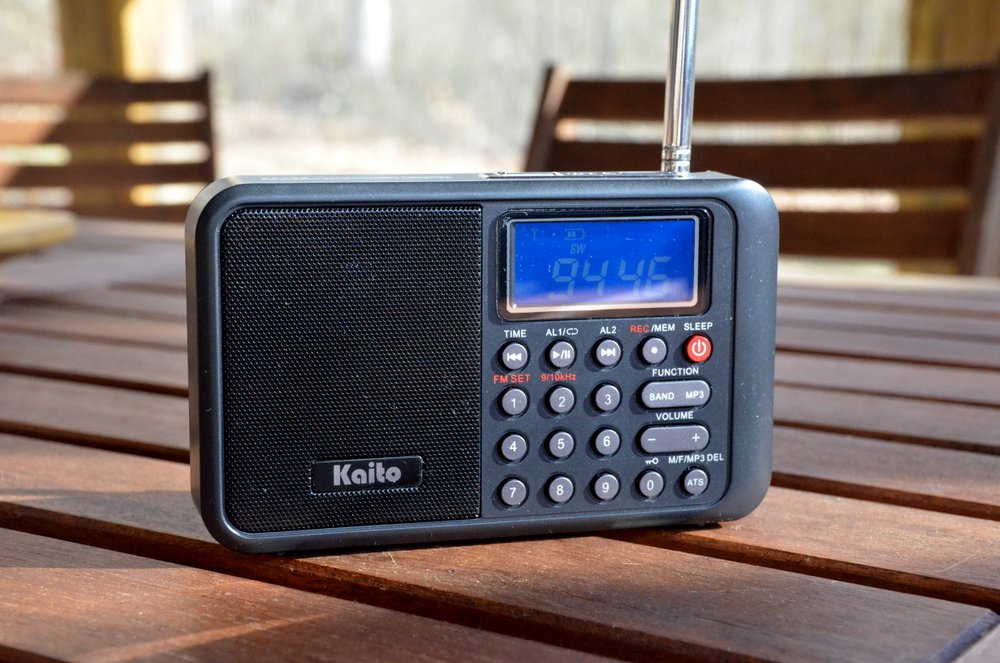
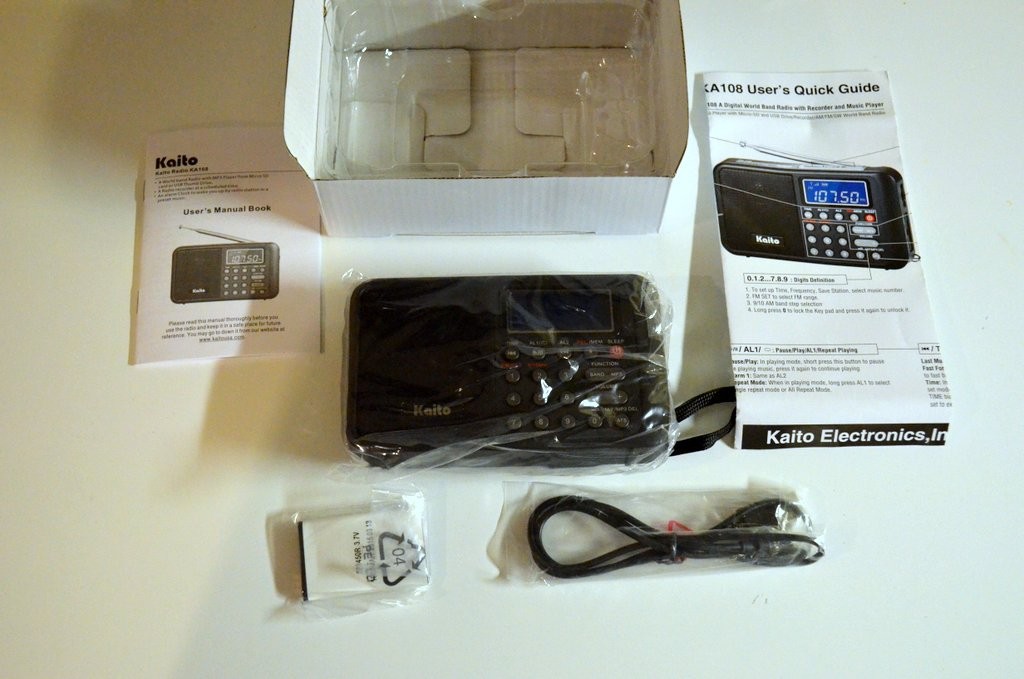
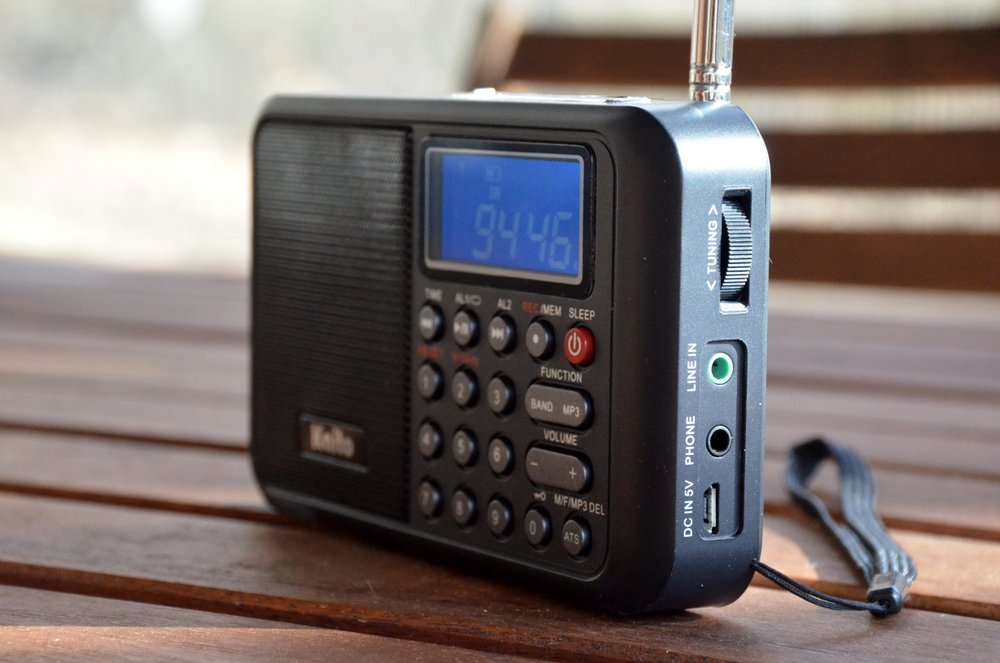
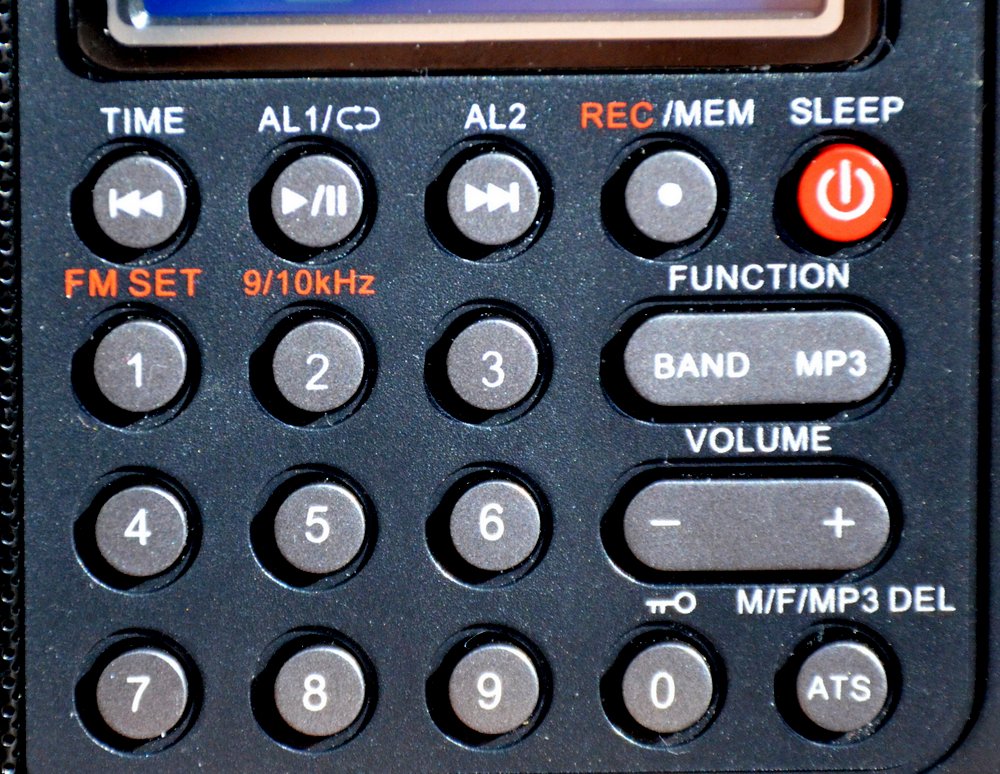
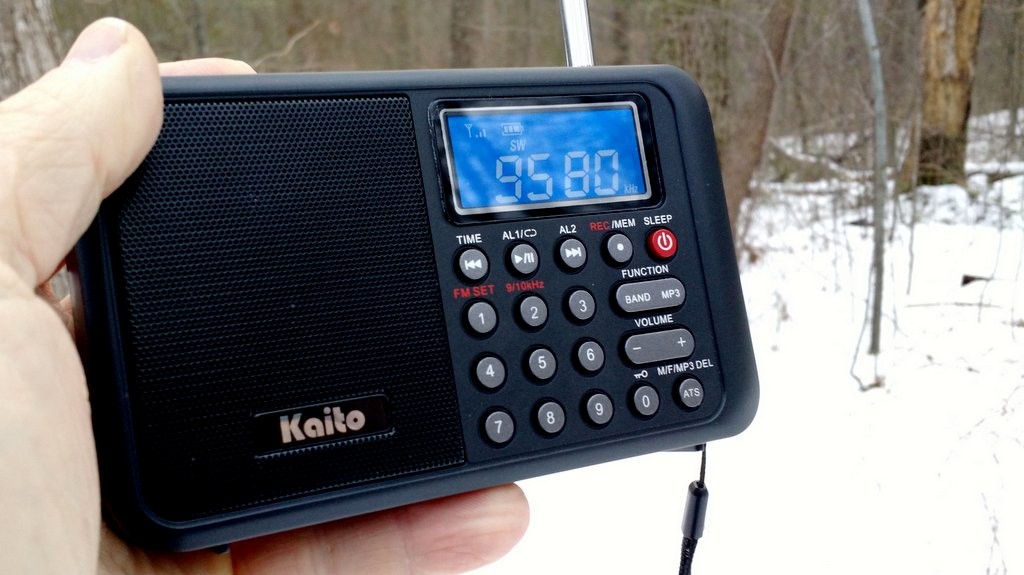
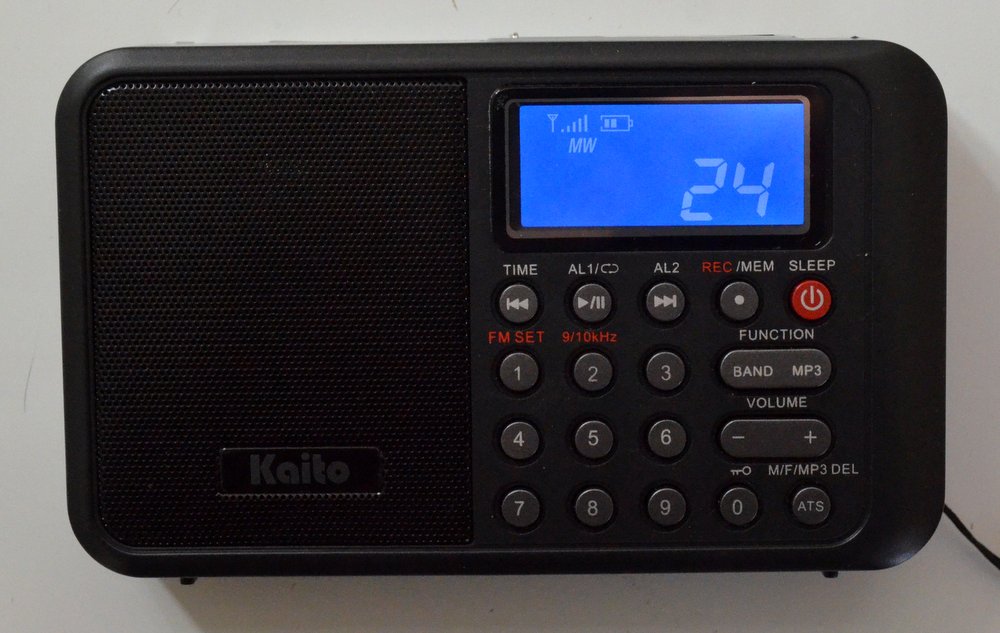

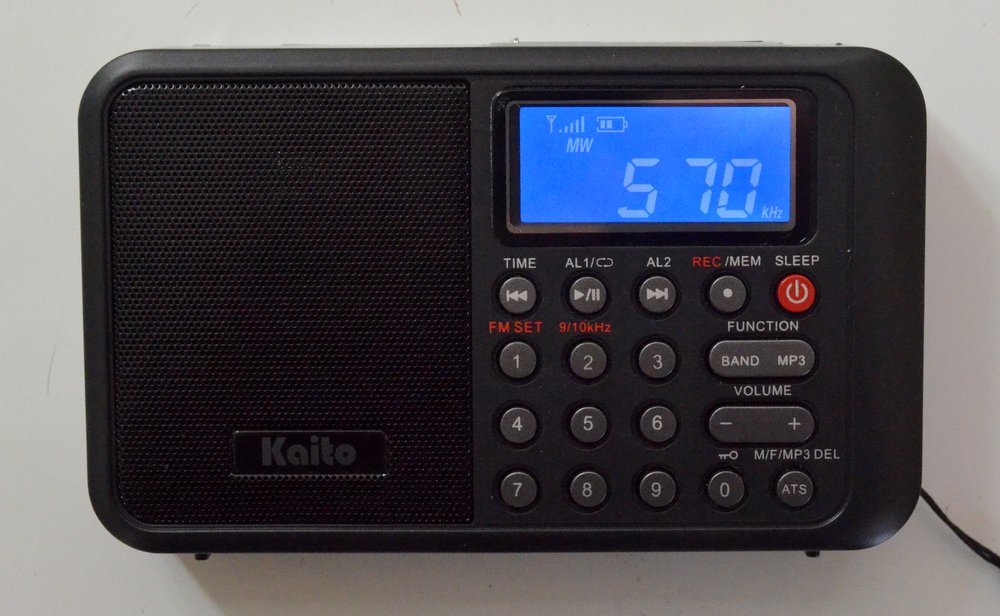
Hi:
I was just wondering if you could setup a timer recording while using the line-in feature to feed it an audio source. That way you can bypass the the crappy internal am/sw tuner with a better radio. Also what is the maximum duration that a timer recording event can be set. Looking at the quickstart guide (at Universal Radio) the alarms are limited to 180 minutes. I’m guessing that is what the limit is ( 4 hours is needed for C2CAM). Since it has 2 alarms i’m guessing that that means that you could setup 2 independent timer recording events. I looked around for a pdf of the user manual but was unsuccessful. I would hope that you might consider offering links to the user manual when you do reviews as this would make your reviews even better.
I think that there is a need for an mp3 device that can be used to schedule timer recordings of radio programs. Some radio programs charge for their podcast like C2CAM. If they did this I think it would sell well.
Thanks
When I first saw a picture of the KA 108 , I hoped it was a repackaged
Kaito/Degen 1103 –
If they could get that sensitivity with better Audio [ including Tone Adjust for music or voice – bass rolloff ] and add working SYNC and other controls for a high end portable- a great Radio could result.
I wish we can get superior versions of the Tecsun PL 880 and Grundig Satellit at $200 .
Great article. This is really a pity this good looking radio doesn’t have a better SW and AM performance, but after reading your review there are no doubts and will not buy it. I have seem some other apparently nice Chinese and Japanese small portables that were plagued with internal birdies specially in AM. Thanks for saving me not only a few euros but also to be deceived again.
Have you heard of or seen the Eton’s Grundig G2 Reporter? same all-in-one category, with 2 speakers instead of one.. rather small, fits in pocket, so perhaps the speakers are weak???
I have a G2 Reporter. I got mine on eBay for $60, and Universal’s been closing them out for that price. For $60 I’m very pleased, although here in the city, the DSP circuit gets overloaded by strong MW locals, so I have to keep the antenna short for SW listening here. On N9EWO’s website I learned a GREAT trick for better battery life: in settings, change the radio from standby mode to sleep mode. MUCH better battery life when this is done! The G2 Reporter isn’t a super high performance radio, but I find it acceptable for my location, and the recording function makes it a must-have for me.
My KA108 arrived this week. Your great video clips had convinced me that I could live with the AM audio, and for the most part, I can understand voice on any decent AM signal. Some treble on top would be nice, but I don’t want them to take out any of the nice thumping bass. For me the bass is a novelty in a radio this size. Having other DSP radios of this class, I knew what to expect in reception. The main nagging problem with all of mine is the severe mediumwave breakthrough across all of shortwave. This needs to be dealt with. So far I think the best radio section of a recordable radio is on the DE1121. I hope we can see a good quality SW/MW/FM recordable before much longer!
Hope they get rid of muting! That is why I want a manual with a good schematic to find out what etch to cut or part to remove. Done it before
Thanks for this review. I’m a huge fan of recordable radios, and was excited to see this one come along. I was hoping though that it woud be improved radio-wise over existing ones. I’ll still likely buy one…I could sort of make out the AM audio in your videos, and I’m fairly easy to please. You’ve also made me want a Traveler III, though! 🙂
-Chuck
….some questions, Mr. Thomas……why is “muting” such an undesirable issue, and if it comes as a radio (dsp) design, how can we ignore it or “fix” it so as not to bother the listener? I don’t understand “soft” or “hard” mute, and how does it come into the design of the radio?….I am a novice in this field, although I have owned a few radios (Nordmende Galaxy, Sony Icf-7600)….rsvp and thanks!
Hi, Mike,
Muting is annoying because it makes band scanning (tuning up and down the band, listening for stations) slow and cumbersome.
On the KA108, for example, as you tune up the band, each increment (5kHz, for example), you have to pause, wait for the audio to come back, then listen for signs of a signal. If no signal, then you move up one more step, then repeat the process.
Most of the quality portables on the market either have no muting between frequency changes, of the muting period is very short. On the PL-660, for example, I can band scan very quickly because I can listen as I tune–there is not muting at all. Of course, true analog radios have no muting between frequencies either.
This can most likely be fixed by Kaito through a firmware modification.
I hope this helps, Mike!
Cheers,
Thomas
I am gad I waited!
This baby was in my want list. I was started to see it was such a tiny baby!
My Grundig traveler and Tecsun PL-606 are no-nonsense no tricks radios withoud S card functions. I needed no-nonsense work radios in the same price range. I don’t need to pay for hassles.
Yoda
I am awaiting one via amazon.com. However, I didn’t buy it for the radio but for its ability to play mp3 files from a USB stick. See, I rip language courses from my CDs and wanted something small/handheld with a speaker to be easily able to move around with. From your review, it seems I made a good choice for my need. The radio is of no interest to me. In fact, I wish it didn’t even have radio abilities, so it could have been cheaper.
With shortwave radios like a Tecsun PL 600 and PL 680 around my place, I hardly needed a cheapo radio.
Yes–for your particular application, I think you will be satisfied. I think I’m going to turn mine into a small mp3 player that simply feeds audio into my SStran AM transmitter. The battery life is pretty good (not stellar, but good). Since it doesn’t have to be plugged in, there’s no 60 cycle hum from a wall wart.
I received the unit and here is my quick review.
The good is the mp3 abilities. Using a USB stick with spoken word mp3s (language lessons, lectures and downloaded radio shows), this proved to be a decent unit with good sound. The handheld size made it very portable for taking onto my balcony and relaxing with a cigar while listening. I wanted a small mp3 player with a speaker and got it.
The bad was the radio aspect. AM/FM is on a level with a sub $10.00 portable. For about half the price I get far superior AM/FM reception on my Sony IC38! The KA108 receives even local powerhouse stations with a little weakness. Useless.
Shortwave is an absolute joke, too. For the price, I can get superior reception elsewhere. For a little more money, I can get far superior reception.
While the speaker is fine on mp3s, it is horrible on the radio bands. Add too this the horrible muting problem that make you not want to actually tune but just punch in a frequency directly and you have a totally useless radio.
Overall, this is an mp3 player. Under no circumstances buy this for the radio (in)abilities, or you will be very sorry.
This should have been released as a stand alone portable mp3 player. Adding the lousy radio aspect will probably cause this unit to lose sales, once the negative reviews get around.
If Kaito is smart, they will redo this unit without the radio, add the ability to navigate folders and re-release it as a small but feature packed handheld mp3 player.
Am I sorry I bought it? No, because it does what I wanted. There aren’t many units out there that met my needs, a small portable mp3 player with a speaker. However, I do feel it is over-priced for its one good feature.
Review update: Don’t buy this unit unless you need more aggravation in your life or an expensive paperweight!
Within a couple of days of light use as an mp3 player, the unit started showing the following defect – half the time when you press the Play/Pause, FF or Rew buttons, it will send you back to the beginning of the track you were playing, regardless of which of the three buttons you press! This is particularly bad when you are ten minutes into a thirty minute language lesson or lecture. Much of the rest of the time, the FF and Rew buttons may initially work properly UNTIL you remove your finger, at which time – take a guess – they will send you back to the beginning of the track you were listening to!
Anyone who has ever done audio based language lessons will know that there are times you need to pause in order to repeat a sentence or word. At other times, you will want to rewind a few seconds to listen again to something which was said. Well, with the defective buttons, you will spend more time repeatedly trying to get back to the point where you were rather than playing mp3s.
I am returning this piece of trash to amazon for a refund. I don’t want another.
Kaito sh9ould immediately withdraw this unit from the market, as it is a piece of junk, especially for the price. In addition, retailers like amazon and Universal should return their stock and refuse to sell it, since it has gotten such lousy overall reviews.
Kaito knows what junk this is and still sent it out to the market. Shame on you, Kaito!
Did you try off tuning by one or two kHz to improve the audio? As far as the off tuning doesn’t attenuate the carrier, this shouldn’t cause increased distortion, but you should get the higher tones from one or the other edge of the signal.
This is an interesting proposition. If it is a standard superhet, that will work by repositioning the sideband inside the IF passband filter. If it is a digital DSP direct conversion it would not.
The off tuning trick works even in the Twente WebSDR. Try to receive an AM signal using the AM-nrw setting and tune off. This has similar effect on audio quality as making the bandwidth wider. In my opinion off tuning is preferred because one can select the better sideband for listening and because it does not increase processor loading.
I use the off tuning trick also in my Tecsun PL-606 dsp radio. In this way I can get rid off the soft muting in addition to the other benefits.
Tuning off-frequency does help a little in some circumstances. It can improve intelligibility somewhat, but sadly the audio is still mostly muffled.
Thanks for the thorough review. You confirmed my suspicions. It takes considerable skill to integrate additional microcontroller logic into a radio without drowning it in RFI. That’s the reason you can’t even find a decent external battery-powered speaker that you can connect to your radio without wiping out the incoming signal. Tecsun would be onto a winner if they integrated a recorder into their PL360/PL365 unit without compromising its reception performance. It certainly has enough room for a micro-SD card slot. Tecsun, I hope you’re listening!
Even Grundig (when it still was that iconic German radio maker) failed at that when they unleashed their Satellit 300/400 models onto the unsuspecting SWL community. Particularly the lower bands suffered QRM from the processor a lot, most noticeable in SSB, not to mention all the birdies in between the noise. 🙂
I’m happy that someone else has had this same problem. I have several portable radios which I like to take to the local mountains for FM dxing. To upgrade the sound, and make the batteries last longer, I like to connect them via 3.5mm cable to my various portable speakers. With the radios tuned in with clear sound my JBL Charge and Oontz XL will completely wipe out the incoming signal to nothing but static when plugged in. I also have some speakers that do not affect the radio output. I’ve just always wondered what the difference is.
These “digital” speakers with amplifiers are QRM generating devices. I made a homemade speaker/amplifier all analog parts and I have no QRM.
Thank you! I am glad this objective review sheds light on the pros and cons. You did me (and others) a great service. I do not understand why they put that mute in the tuning system, That is annoying. I have a Radio Shack DX-390. I found the mute diodes and disconnected them as well as the piezo beeper also a “peep-peep” when you push the keys.. I will pass on the Kaito. You saved me bundle for a better radio. I wish they would have a service manual. I buy the service manual first, then get a good feeling for the innards and be out only the price of the service manual. I have manuals to appliances I never purchased as well as never purchasing products they will not offer a service manual too.
The mark of a good review is of course to show strengths and weaknesses – I always appreciate your reviews because you do not merely trash something, but highlight what is good. Sadly this is another example of a radio which has good intentions, but which obviously misses the mark by a fairly wide margin.
Very thorough review as usual – this is why you are a trusted source of information. I have purchased more than one radio because of your assessments! Keep up the good work!!
Excellent review, as always Thomas … much appreciated.
I’m disappointed for the same reasons you are. Hopefully the changes you suggested will be made by Kaito and those changes would make this one of the better small radios out there. In the mean time I’ll stay tuned to see what develops.
Keep up the great work.
An unbiased, informative, superb review by Thomas…Many thanks…
Another excellent review. I just did a YouTube video referring to your review and your YouTube videos. Thanks for your excellent review.
Thank you, Tom! And thanks for the work you put into your many fine videos!